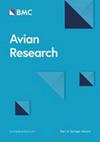黑尾Godwit的三个亚种共享世界上最大的河流三角洲的非繁殖地
IF 1.7
2区 生物学
Q1 ORNITHOLOGY
引用次数: 0
摘要
在非繁殖期(9月至4月),黑尾Godwits (Limosa Limosa)在孟加拉国恒河-布拉马普特拉河-梅克纳河三角洲的沿海和内陆湿地中很常见。我们假设恒河-布拉马普特拉河-梅克纳三角洲,在中亚和东亚-澳大拉西亚飞行路线的重叠处,可能有三个亚种在温带和北亚的分离区域繁殖:L. L. limosa, L. L. melanuroides和L. L. bohaii。我们使用线粒体DNA (mtDNA)单倍型网络和生物特征分析来确定捕获个体的亚种,并部署GPS-GSM发射机来验证具有亚种分配的个体的繁殖区域。为了测试不同的栖息地偏好,我们在两个生态截然不同的栖息地对鸟类进行了采样,这些栖息地已知是孟加拉国非繁殖黑尾Godwits最集中的栖息地:Nijhum Dweep国家公园,一个位于中南部海岸的咸淡水潮汐海岸栖息地,以及Tanguar Haor(“backmarsh”),一个位于北部的季节性淡水泛滥平原。在2021-2022年和2022-2023年的非繁殖期,我们对93只黑尾鹬进行了采样和测量,其中54只配备了GPS-GSM发射机。我们的mtDNA单倍型网络分析证实,在研究地点存在limosa, melanuroides和bohaii亚种。因此,事实上,黑尾Godwits亚种,尽管有不同的繁殖范围,但在亚洲表现出(部分)重叠的非繁殖范围。不同地点的亚种组成差异显著,在坦瓜哈尔以limosa和bohaii亚种为主,在尼胡姆Dweep以melanuroides亚种为主。在追踪到繁殖地的21只个体中,有18只迁移到了各自亚种的预期繁殖范围。然而,一只带有鹅毛线虫单倍型的鸟迁移到了已知的渤海繁殖区,而两只带有黑尾线虫单倍型的鸟迁移到了假定的鹅毛线虫繁殖区。因此,虽然迁徙路线两端的生态因素可能会影响黑尾Godwit亚种之间形态和行为的差异,但它们的描述和可能的基因流动需要进一步的研究。本文章由计算机程序翻译,如有差异,请以英文原文为准。
Three subspecies of Black-tailed Godwit share non-breeding sites in the world's largest river delta
During the non-breeding season (September–April), Black-tailed Godwits (Limosa limosa) are commonly seen in coastal and inland wetlands of the Ganges-Brahmaputra-Meghna Delta in Bangladesh. We hypothesize that the Ganges-Brahmaputra-Meghna Delta, at the overlap between the Central Asian and East Asian–Australasian flyways, may host three subspecies that breed in disjunct areas of temperate and northern Asia: L. l. limosa, L. l. melanuroides, and L. l. bohaii. We used mitochondrial DNA (mtDNA) haplotype network and biometric analysis to determine subspecies in captured individuals, and deployed GPS–GSM transmitters to verify breeding areas of individuals with subspecies assignments. To test for differential habitat preferences, we sampled birds at two ecologically distinct habitats known to host the largest concentrations of non-breeding Black-tailed Godwits in Bangladesh: Nijhum Dweep National Park, a tidal coastal habitat with brackish water on the south-central coast, and Tanguar Haor (‘backmarsh’), a seasonal freshwater floodplain in the north. During the non-breeding seasons of 2021–2022 and 2022–2023, we sampled and measured 93 Black-tailed Godwits, 54 of which were equipped with GPS–GSM transmitters. Our mtDNA haplotype network analysis confirmed the presence of limosa, melanuroides, and bohaii subspecies at the study sites. Thus, indeed, Black-tailed Godwits subspecies, despite having distinct breeding ranges, exhibit (partially) overlapping non-breeding ranges in Asia. The subspecies composition differed significantly between sites, with limosa and bohaii dominating in Tanguar Haor and melanuroides in Nijhum Dweep. Of the 21 individuals that were tracked to their breeding grounds, 18 migrated to the expected breeding range of their respective subspecies. However, one bird with a limosa haplotype migrated to a known breeding area of bohaii, whereas two birds with melanuroides haplotypes migrated to the supposed breeding range of limosa. Therefore, while ecological factors at both ends of the flyways may shape the morphological and behavioural differences between Black-tailed Godwit subspecies, their delineations and possible gene flow require further studies.
求助全文
通过发布文献求助,成功后即可免费获取论文全文。
去求助
来源期刊

Avian Research
ORNITHOLOGY-
CiteScore
2.90
自引率
16.70%
发文量
456
审稿时长
46 days
期刊介绍:
Avian Research is an open access, peer-reviewed journal publishing high quality research and review articles on all aspects of ornithology from all over the world. It aims to report the latest and most significant progress in ornithology and to encourage exchange of ideas among international ornithologists. As an open access journal, Avian Research provides a unique opportunity to publish high quality contents that will be internationally accessible to any reader at no cost.
 求助内容:
求助内容: 应助结果提醒方式:
应助结果提醒方式:


